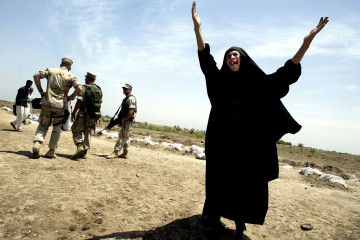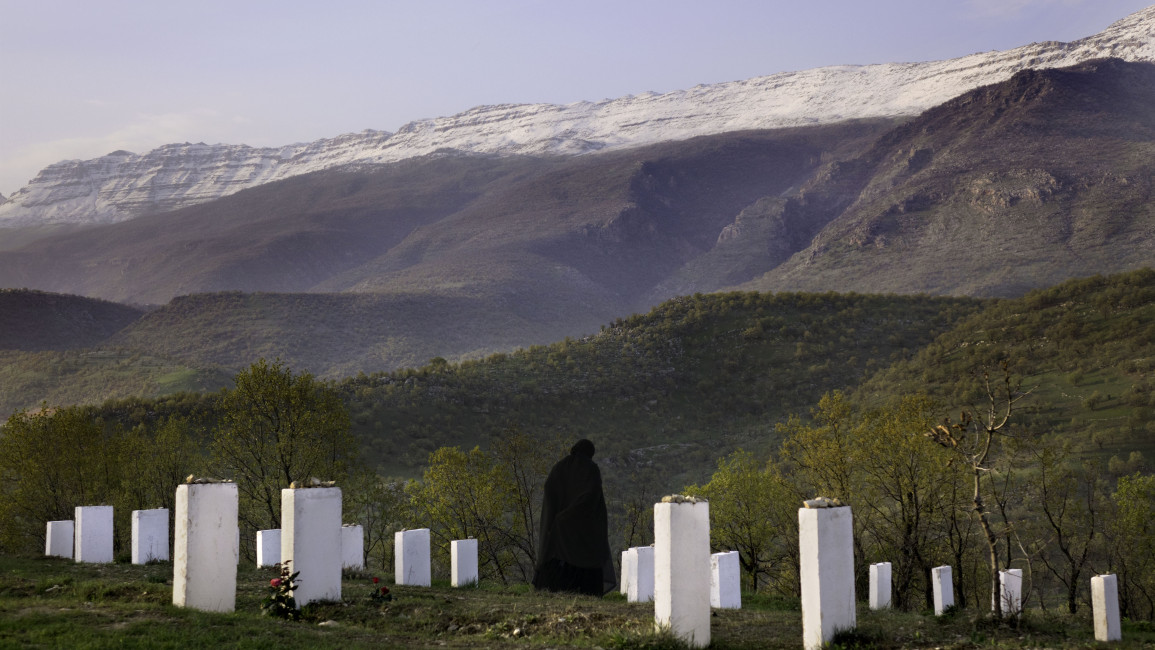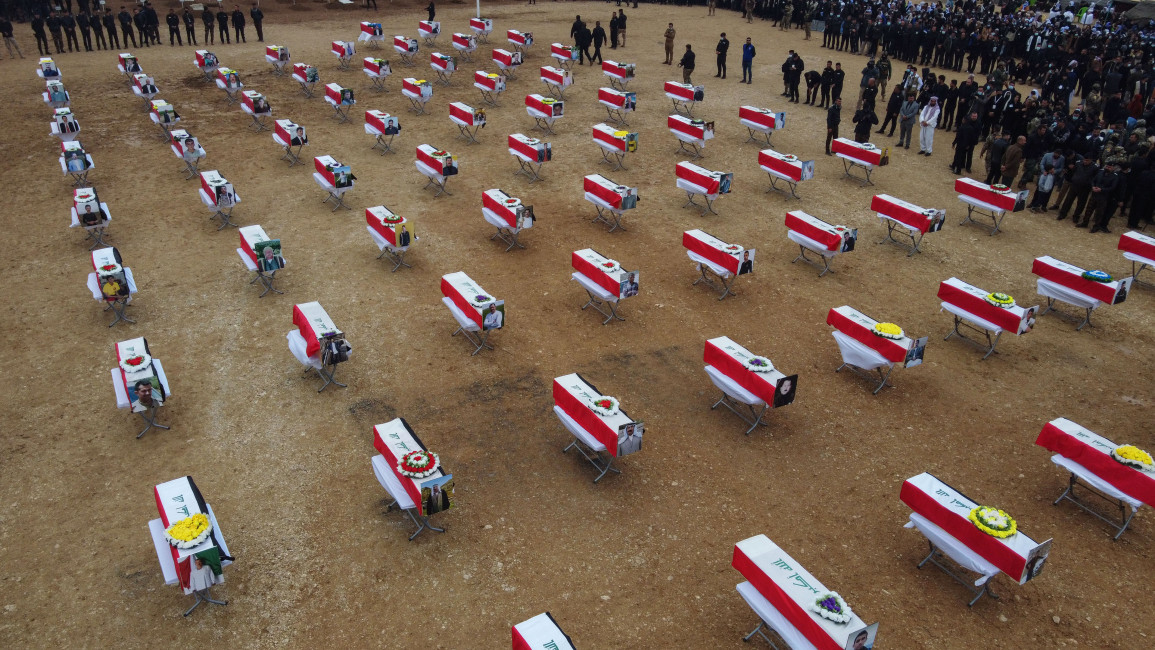
The long and brutal history of enforced disappearances in Iraq
Iraq has one of the largest numbers of missing persons worldwide, with up to one million people having been forcibly disappeared in the past 50 years.
The spate of people who were "disappeared" throughout Iraq over the past century has once again been raised by the United Nations Committee on Enforced Disappearances (CED).
In a recent statement, the committee "urged Iraq to immediately establish the basis to prevent, eradicate and repair this heinous crime," noting that enforced disappearances aren't clearly defined as a crime under Iraqi law.
The committee estimates that 250,000 to one million people have disappeared in Iraq since 1968 when Saddam Hussein's Baath Party seized power. The broad estimate is unsurprising considering the scale of the atrocities that has seen large numbers of people forcibly disappeared in Iraq since 1968.
As a result, Iraq has one of the largest numbers of missing persons worldwide.
"A UN committee estimates that 250,000 to one million people have disappeared in Iraq since 1968, when Saddam Hussein's Baath Party seized power"
As early as 1969, Saddam Hussein set the tone for what would come under his rule. He met a family who had a relative unjustly executed by the Baath Party and insisted they take the blood money the regime offered them.
"Take the money," he reportedly told them. "Do not think you will get revenge, because if you ever have the chance, by the time you get to us, there will not be a sliver of flesh left on our bodies."
Saddam's tyrannical reign had consequences that would affect Iraqis of various backgrounds for generations.
In the 1970s, the regime uprooted and deported hundreds of thousands of Persian Iraqis who had lived in the country for millennia. After defeating the Kurdish movement in 1975, the regime moved to ‘Arabise’ parts of the country, destroying hundreds of Kurdish villages in the process, especially in Kirkuk province.
RELATED
Seeking justice for the Anfal atrocities
In-depth
Dana Taib Menmy
That was a mere preview of the crimes the Baathists would perpetrate in the 1980s. In 1979, Saddam consolidated his power with an infamous purge of his parliament, becoming the undisputed ruler of Iraq. In 1980, he invaded Iran, initiating a war that lasted eight years and left at least a million dead in its wake.
In 1983, he moved against the Barzani tribe in Iraqi Kurdistan. He condemned them as collaborators of Iran and subsequently had 8,000 of the tribe's men and boys disappeared, leaving their women, traditional homemakers who did not previously work or independently earn money, destitute and fending for themselves.
In a visit to Iraqi Kurdistan's Erbil that year, Saddam said the Barzanis were "severely punished and have gone to hell".
Only after Saddam was deposed in 2003 did Kurds begin to retrieve the remains, buried hundreds of miles from Iraqi Kurdistan in Iraq's desert border regions. Bodies of Barzani males who disappeared that year continue to be found 40 years later.
In July 2022, 100 bodies found in mass graves in southern Iraq were returned to Barzan in Iraqi Kurdistan for burial. Kurdish leader Masoud Barzani expressed his condolences and hope that "their souls are in better places".

Next to the village of Barzan graves have been dug for the Kurds that were killed during the Anfal, a series of genocide campaigns Saddam Hussein led from February to September 1988 to eradicate the Kurdish people. [Getty]
The mass killing of the Barzanis was followed by the Anfal ("spoils of war") campaign that began in 1987. That brutal campaign saw Iraqi forces murder an estimated 182,000 people, including 5,000 men, women, and children, in a single day in the infamous bombing of Halabja with chemical weapons on 16 March 1988.
Human Rights Watch (HRW) concluded that Saddam's regime "committed the crime of genocide" for its actions against Kurds in this period.
Following the 1991 Persian Gulf War, after Iraq was expelled from Kuwait by a multinational US-led coalition, the Kurds in the north and the Shia Arabs in the south revolted against Saddam, hoping the US would support them. It did not.
While US intervention in the north helped the Kurds establish their autonomous region outside of Saddam's control, he still retained control over the Shia south and cracked down hard.
"Twenty years after Saddam Hussein's tyrannical regime was deposed, enforced disappearances remain widespread in Iraq"
"Thousands of Shi'a, including hundreds of clerics, have been imprisoned without charge or have disappeared in state custody since the uprising; many Shi'a shrines and institutions in al-Najaf and Karbala were devastated during the rebellion or demolished by government forces in its aftermath," read a 1992 HRW report.
In 2003, Saddam was toppled by a swift Anglo-American ground invasion of Iraq, briefly kindling hopes that better days were ahead for the brutalised Iraqi people. The uncovering of mass graves revealed the extent of the toppled dictator's crimes against Iraqis. Still, many of the disappeared remained missing or unidentified.
Iraq entered a new phase marked by sectarian violence and terror. Even though Saddam was gone, Iraqis continued to suffer from enforced disappearances. During the violence that brought the country into a state of civil war in the late 2000s, sectarian murders were rife, as were disappearances at the various checkpoints ordinary Iraqis had to pass through every day by soldiers, police, and militiamen.
The mass killing of the Barzanis was followed by the Anfal ("spoils of war") campaign that began in 1987. That brutal campaign saw Iraqi forces murder an estimated 182,000 people, including 5,000 men, women, and children, in a single day in the infamous bombing of Halabja with chemical weapons on 16 March 1988.
Human Rights Watch (HRW) concluded that Saddam's regime "committed the crime of genocide" for its actions against Kurds in this period.
Following the 1991 Persian Gulf War, after Iraq was expelled from Kuwait by a multinational US-led coalition, the Kurds in the north and the Shia Arabs in the south revolted against Saddam, hoping the US would support them. It did not.
While US intervention in the north helped the Kurds establish their autonomous region outside of Saddam's control, he still retained control over the Shia south and cracked down hard.
"Twenty years after Saddam Hussein's tyrannical regime was deposed, enforced disappearances remain widespread in Iraq"
"Thousands of Shi'a, including hundreds of clerics, have been imprisoned without charge or have disappeared in state custody since the uprising; many Shi'a shrines and institutions in al-Najaf and Karbala were devastated during the rebellion or demolished by government forces in its aftermath," read a 1992 HRW report.
In 2003, Saddam was toppled by a swift Anglo-American ground invasion of Iraq, briefly kindling hopes that better days were ahead for the brutalised Iraqi people. The uncovering of mass graves revealed the extent of the toppled dictator's crimes against Iraqis. Still, many of the disappeared remained missing or unidentified.
Iraq entered a new phase marked by sectarian violence and terror. Even though Saddam was gone, Iraqis continued to suffer from enforced disappearances. During the violence that brought the country into a state of civil war in the late 2000s, sectarian murders were rife, as were disappearances at the various checkpoints ordinary Iraqis had to pass through every day by soldiers, police, and militiamen.
RELATED
Iraq's long road to justice for the Yazidi genocide
Analysis
Rachel Hagan
The rise of the Islamic State (IS) group in 2014 led to a new round of disappearances and atrocities in Iraq. The group infamously conquered one-third of the country that year and subjected the Yazidi minority in northern Iraq to a systematic campaign of abductions and genocide.
Yazidi males were summarily executed, while women and girls were enslaved and raped. Even after the last of the territory that made up IS's self-styled caliphate was recaptured in 2019, thousands of Yazidis remained missing.
The Free Yezifi Foundation estimates that IS enslaved 6,417 Yezidi women and children and that over 2,693 Yezidi men and women remain missing. The majority of them are presumed dead.
The Shia-majority Popular Mobilisation Forces (PMF) were formed in response to IS's onslaught. Some of the more extreme elements fighting under the PMF umbrella carried out retributions against Sunni populations.

An aerial picture shows mourners gathering around coffins wrapped with the Iraqi flag during a mass funeral for Yazidi victims of the Islamic State (IS) group in the northern Iraqi village of Kojo in Sinjar district, on 6 February 2021. [Getty]
In 2017, Amnesty International reported that 643 men and older boys in Anbar province's Saqlawiya disappeared after being abducted by PMF forces as they fled the June 2016 battle of Fallujah and separated from their families.
In 2018, HRW noted that thousands of Iraqi men faced arbitrary arrests by government forces and the PMF, which was officially a state paramilitary. The overwhelming majority of cases that HRW report documented were Sunni Arab males as young as nine and as old as 70.
Such cases demonstrate the sad fact that 20 years after Saddam Hussein's tyrannical regime was deposed, enforced disappearances remain widespread in Iraq.
This state of affairs has led some to lament that Iraq merely transitioned from a republic of fear under Saddam – where Iraqis feared running afoul of the authorities and being forcibly disappeared and brutally tortured – to a republic of terror under militias, many of them officially state-sanctioned.
"The Iraqi people used to know exactly who it was who killed them, whereas today they are ignorant of the exact identity of their killers"
"Perhaps the sole major difference left between then and now is that in the Republic of Fear, the source of that fear was known, whereas its source is now obfuscated in today's Republic of Terror," wrote Dr Munqith Dagher in 2020.
"The Iraqi people used to know exactly who it was who killed them, whereas today they are ignorant of the exact identity of their killers."
The UN committee's report is a reminder that conclusively determining what happened to those Iraqis who have disappeared since 1968 remains important, as is taking firmer steps to end this cruel practice once and for all.
Paul Iddon is a freelance journalist based in Erbil, Iraqi Kurdistan, who writes about Middle East affairs.
In 2017, Amnesty International reported that 643 men and older boys in Anbar province's Saqlawiya disappeared after being abducted by PMF forces as they fled the June 2016 battle of Fallujah and separated from their families.
In 2018, HRW noted that thousands of Iraqi men faced arbitrary arrests by government forces and the PMF, which was officially a state paramilitary. The overwhelming majority of cases that HRW report documented were Sunni Arab males as young as nine and as old as 70.
Such cases demonstrate the sad fact that 20 years after Saddam Hussein's tyrannical regime was deposed, enforced disappearances remain widespread in Iraq.
This state of affairs has led some to lament that Iraq merely transitioned from a republic of fear under Saddam – where Iraqis feared running afoul of the authorities and being forcibly disappeared and brutally tortured – to a republic of terror under militias, many of them officially state-sanctioned.
"The Iraqi people used to know exactly who it was who killed them, whereas today they are ignorant of the exact identity of their killers"
"Perhaps the sole major difference left between then and now is that in the Republic of Fear, the source of that fear was known, whereas its source is now obfuscated in today's Republic of Terror," wrote Dr Munqith Dagher in 2020.
"The Iraqi people used to know exactly who it was who killed them, whereas today they are ignorant of the exact identity of their killers."
The UN committee's report is a reminder that conclusively determining what happened to those Iraqis who have disappeared since 1968 remains important, as is taking firmer steps to end this cruel practice once and for all.
Paul Iddon is a freelance journalist based in Erbil, Iraqi Kurdistan, who writes about Middle East affairs.
No comments:
Post a Comment